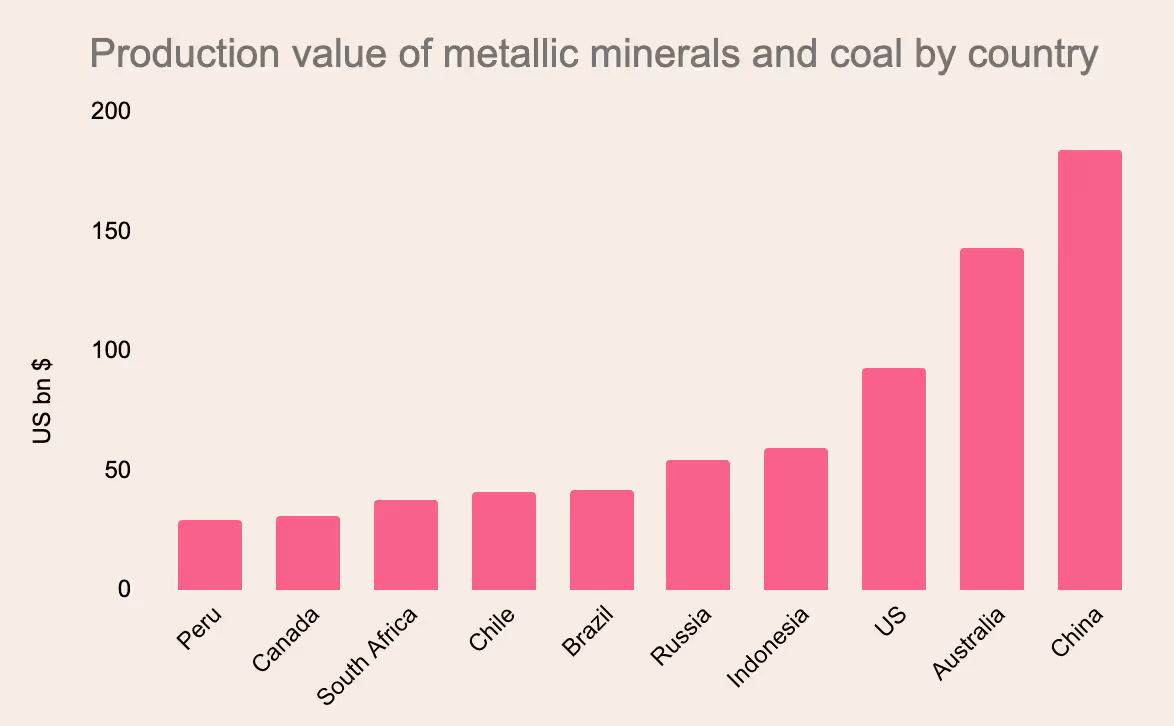When you’re looking around for long-term investments for your portfolio during both the rocky and the smooth times, it might be worth digging into mining stocks. And luckily, you don’t have to be one of Snow White’s Seven Dwarfs to access a realm of underground mining investments either.
From South Africa to Brazil, the mining industry is a global venture. It involves digging up a diverse range of raw materials and minerals, usually exported for use in goods from batteries to jewellery.
The mining sector encompasses typically less glamorous businesses like those in the steel industry, iron ore production, and copper mining operations. And then there are the flashier elements, where you might want to invest in a gold mining company, diamond mines or other precious metals mining companies.
When it comes to investing in mining stocks though, it’s not all about the price of the metal they’re mining in the first place.
The share prices of even the largest miners like Barrick Gold (GOLD) or Glencore (GLEN) are tied to a lot more than just the spot price of the element being dug up. These are complex and varied stocks with plenty of market factors and influences impacting their stock prices. So before you consider adding a mining stock to your portfolio, make sure you understand the sector-specific factors that could impact your investment.
Read more
- Mistakes to avoid when transferring your ISA
- Stocks and shares ISA rules
- Dividends and your stocks and shares ISA
What are mining stocks?
When trying to scope out the mining industry for potential long-term investment ideas, it’s worth having a decent foundation of the mining sector and the typical types of mining operations carried out by the small-cap miners, the largest miners, and everything in between.
Some of the key mining industries in the broader market operate in areas you may already be familiar with. But other commodity investments will likely be niches that fall outside of regular day-to-day usage. Here are the main mining sectors that most mining stocks tend to fall into:
- Minerals - Mined minerals like bauxite, phosphate rock, and gypsum are used to make building materials, detergents and insecticides.
- Precious metals - this includes silver, gold and palladium, which tend to carry value as icons of perceived value.
- Energy materials - this includes nuclear materials like uranium, fossil fuels like coal and lithium mining stocks.
- Base metals - this includes firms involved in nickel, steel, and copper mining operations.
- Building materials - this includes iron ore production, often used in building new developments and building structures.
In addition to the diversity of metals mined, this industry is globally diverse too.
Here’s what the leading 10 mining countries look like based on their value of minerals produced, according to the ICMM Mining Contribution Index (MCI):

While this wide geographic spread can be good to add diversity to your portfolio, it can also mean you’re exposed to additional geopolitical risks. Regulations are a big hurdle for many mining companies looking to open up shop in new countries.
And the currency effects, be they headwinds or tailwinds, can have significant impacts on a company’s bottom line. So keep in mind where your investments have their operations based, and where the end-consumer lives, and where the firm is listed.
The UK market has a chunky exposure to mining stocks but nearly all of them have operations outside British borders. When the pound is weak, it can make those foreign earnings look better, as they’re worth more when converted into sterling.
Another important mining industry subtlety to wrap your head around is that mining stocks can typically be broken down by size. There are no strict thresholds to separate the major producers from the smaller mining projects, but investors tend to roughly divide mining stocks into the largest miners and the junior miners.
Large mining stocks
We tend to equate ‘bigger’ with ‘better’ but the largest mining companies aren’t necessarily the best investments. Though, companies with larger mining operations tend to have longer histories and more diverse international operations, which can result in more reliable revenue streams.
And these larger firms make up the bulk of the mining industry’s revenues. In 2021, most global mining revenues came from the 40 largest mining companies, accounting for a total of $925bn. That makes it a somewhat top-heavy sector, generally dominated by big companies.
Some of the largest mining company stocks within the mining sector are blue-chip stocks too. Meaning, they often have large market caps, and are household names with well-established, proven financial track records. Often, these firms pay a dividend as well, which can set them apart from the small-cap miners concentrating on putting their profits back into the business.
As environmental, social and governance (ESG) standards become increasingly important for the sector, there is a lot of pressure on these big mining companies to go green. On one hand, they have the chance to lead the charge, but massive mining operations may have a tougher time pivoting to cleaner methods. That means smaller firms, like junior miners, may be better suited for pivoting into greener exploration, production, processing and refining operations.
If the big guns manage it though, they have the opportunity to dominate a new, cleaner industry for years to come.
Junior mining stocks
Junior mining stocks are more likely to concentrate on one specific area or niche, perhaps putting all their effort into establishing themselves as an efficient gold mining company, rather than dabbling in many ventures at once.
When these stocks work out, they can reap big rewards. But they also tend to carry higher risk since they’re reliant on one potential mining site bearing fruit. So investors need to keep in mind that huge growth potential among young and small mining stocks comes with a lot of uncertainty.
Junior miners’ intense focus on just one area can help prevent their business focus from being spread too thin but that’s more a result of having to channel money wisely than anything else. When the bank balance isn’t bulging, you have to be careful where every penny is spent.
The largest miners might be able to move money between sites and projects to fill the gaps or exploit a new field but the effect of striking gold will have a much bigger impact on a small firm.
Again, it’s that risk-reward trade-off that investors need to factor into their own circumstances and tolerance.
Mining sector challenges
As mentioned, one of the biggest obstacles and challenges to both the largest mining companies and smaller mining companies is proper ESG management.
Mining is typically not a very environmentally friendly industry. But for now, the materials it produces are crucial to the smooth functioning of most areas of our lives, which means the industry isn’t going anywhere anytime soon.
That said, firms need to find ways to make mining, exploration and production greener, or else investors could move their money elsewhere. The risks of not adhering to ESG regulations aren’t just about reputation, fines are no joke. Glencore was recently ordered to pay £281m for bribery penalties in Africa, and there are zero doubts that cash’s disappearance will erode shareholders’ returns.
The flip side of this is there could be a real opportunity for firms able to reduce their environmental impact, lead the way on corporate governance or boost the well-being of the societies in which they operate.
Sustainability of business practice breeds sustainability of revenues, by decreasing the likelihood of fines or heavy taxation due to pollution. The race is on to see whether a large-cap miner will put its hand up first or a small mining stock will leapfrog everyone and become the sector’s ESG champion.
What is the best mining stock?
The answer to this isn’t particularly obvious, as you’ll need to dig below the surface to find the best mining stocks for your portfolio. Not only will you have to take a deep look into the broader market, but you’ll also need a thorough understanding of your own long-term investment goals, time horizon, and appetite for risk.
Once you have a clear understanding of your own financial goals and needs, you’ll be best equipped to assess the right mining stock for your portfolio.
One of the best ways to get some investing inspiration as to what the best stocks for you might be, is to look at the most popular mining stocks.
Top 10 mining stocks on Freetrade
Here are 10 of the most popular mining stocks from 2021, which are all available on the Freetrade app. Keep in mind that being popular doesn’t necessarily mean these are the best mining stocks to keep in your portfolio. The best mining stocks for you will be based on your own analysis of your financial goals and needs.
Source: Freetrade 2022
What are mining ETFs?
Alongside picking out individual mining stocks to invest in, another option for investors is to explore some mining ETFs.
A mining ETF (exchange-traded fund) is a single investment that allows you to invest in a basket of multiple mining stocks. This is partly why ETFs are considered one of the best investments for beginners, because you don’t have to do the legwork of stock picking. Each mining ETF will have a particular focus, perhaps concentrating on a given index or mining industry benchmark.
This could involve investing in a group of the largest miners in the broader market, or be centred around one niche such as exclusively copper producers or gold mining stocks.
So, if you’re interested in gaining some exposure to a range of mining companies, an exchange-traded fund can be a useful addition to your long-term investment strategy. For example, investing in something like the VanEck Junior Gold Miners UCITS ETF (GJGB) allows you to invest in a selection of junior gold miners without requiring you to pick out specific stocks.
Though, diversification from investing in multiple stocks isn’t always inherently a good thing. Selectivity is key when it comes to higher-risk, growth-mode stocks like junior miners.
ETFs aren't perfect and still come with drawbacks, like the fact that a sector ETF will be more exposed to specific sectoral influences than a general broad market ETF tracking the S&P 500.
It’s always important to dig under the surface to see exactly what investments any particular ETF invests your money into.
Something else to remember with ETFs is that most will have ongoing costs that you need to be aware of. For example, the VanEck Junior Gold Miners exchange-traded fund has a total expense ratio of 0.55%, but some ETFs can cost more. Also, as we’ve said, relying solely on one ETF means you’re tacking on added industry risk, because if the mining sector as a whole takes a hit, your portfolio will too.
What are mining trusts?
A mining investment trust is a publicly listed company that is actively run by the fund manager, who’s adhering to the trust’s goals as an investment vehicle.
Using an investment trust is another popular way to get exposure to a number of mining stocks in one go, as you would with an ETF, for example.
The BlackRock World Mining Trust (BRWM) is one of the most popular investment trusts on the Freetrade platform. It’s a trust that invests in a blend of mining companies from around the world including Vale SA (VALE), Teck Resources (TECK), and Anglo American (AAL).
Again, investment trusts can benefit from the fact that they come with an expert at the helm. But that’s no guarantee your investment will result in a return, and that manager’s expertise will always come at a fee. So, be sure to know a trust’s ongoing fees before investing.
Another trust-specific feature is their ability to use gearing (borrowing and leveraging money), which can allow them to amplify their returns. But it’s a double-edged sword. As demand for metal and metal prices grow, and the trust’s investments benefit, your investment could too. But, the flipside holds true too, and your losses can grow during a mining downturn.
Mining stock FAQs
Are mining stocks a high risk?
This depends on what you’re looking for and your personal tolerance for risk. Some of the major mining companies can be less risky than other mining stocks because they’re well-established with a long-term pipeline of work underway (which could mean they have secured contracts or locked-in future revenue streams). But as we’ve seen, mounting ESG-related concerns mean these firms could soon be in trouble if their massive legacy operations fail to pivot towards greener alternatives.
Some of the newer junior miners which can offer greater growth potential are also higher-risk investments as they’re often in exploration mode. If they find a site to mine successfully that can mean good returns. If not, they have to keep looking and risk running out of money. To expose your portfolio to higher growth potential, you’ll need to take on that risk too.
Ultimately though, every mining stock will involve a certain level of risk. No stock is immune to the ups and downs of the market, or its respective sector. That’s why it’s crucial you take the time to understand a given stock, ETF or trust’s risk and measure it up against the level you are comfortable with.
What’s the outlook for mining stocks?
Most mining stocks are in the process of extracting materials that are essential to our current day-to-day life. They’re also developing extremely important resources for future development in areas such as transport and EVs.
But, a balance needs to be struck between heavy extraction numbers and climate-friendly policies. Mining companies need to find creative and potentially costly ways to operate in a more ESG-friendly manner. Expenditures now could save them from a very hefty fine (or many) down the line.
Failure to meet ESG requirements could mean that these companies disqualify themselves from a wide range of both retail and institutional investment.
How to invest in mining stocks?
There are a number of ways you can invest in mining stocks. Here’s a quick overview of the investing process if you’re looking to make a long-term investment in a single mining project or the mining industry as a whole:
- Compare brokerage accounts to decide which one best suits your needs.
- Open a share dealing account with your broker of choice. You might want to factor in tax efficiencies here. Think about whether a GIA, stocks and shares ISA or SIPP could help. Once you’ve decided, make your first deposit.
- Research the type of mining stock, ETF, or investment trust you want to invest in.
- Make sure the mining stock fits in with your overall portfolio and diversification strategy, and that the rest of your finances are in a healthy position.
- Select how much of the mining stock you’d like to invest in. You can buy fractional shares on the Freetrade app for US shares, so you don’t have to purchase a full share if it's outside of your budget. Or if you’d just like to start with a smaller mining investment and build up depending on its performance.
For more guidance on investing and how to begin, you can read our in-depth guide on how to invest in stocks. If you do decide to invest in mining stocks, make sure the mining industry is only a part of your diversified portfolio.
As an investor, it’s incredibly challenging to pick investments that will succeed in the long run for volatile commodity-focused sectors like those involved in mining. That’s especially the case for mining stocks wholly dependent on the performance of a single mine, or on accessing natural resources and minerals based in another country. Keep this in mind if you invest in mining stocks, as these come with added risks and potential obstacles that other stocks may not face.

Build your financial knowledge and be in a better position to grow your wealth. We offer a wide range of financial content and guides to help you get the insight you need. For example, learn how to invest in stocks if you are a beginner, how to make the most of your savings with ISA rules or how much you need to save for retirement.
When you invest, your capital is at risk. The value of your portfolio can go down as well as up and you may get back less than you invest. This should not be read as personal investment advice and individual investors should make their own decisions or seek independent advice. Past performance is not a reliable indicator of future results.If you are unsure whether a product is right for you, you should contact a qualified financial advisor.Freetrade is a trading name of Freetrade Limited, which is a member firm of the London Stock Exchange and is authorised and regulated by the Financial Conduct Authority. Registered in England and Wales (no. 09797821).

.avif)










